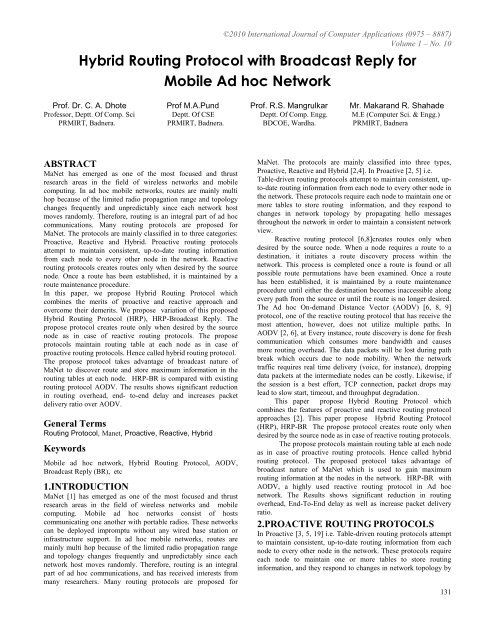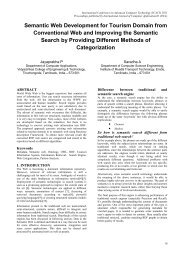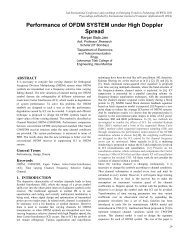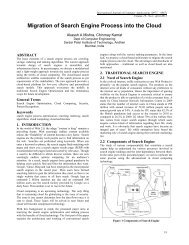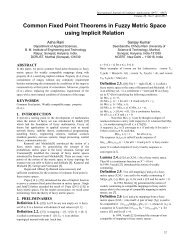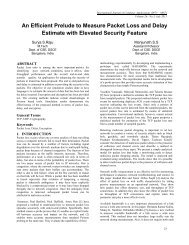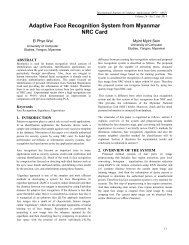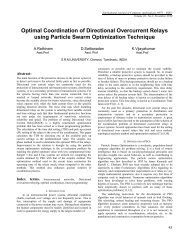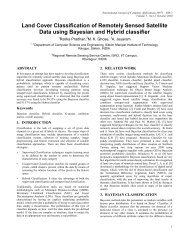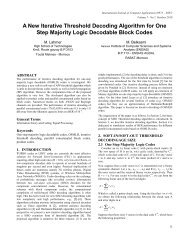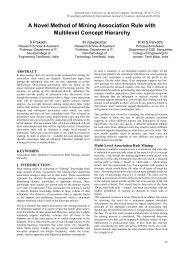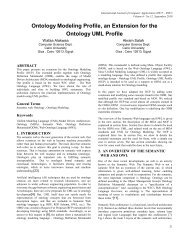Proceedings Template - WORD - International Journal of Computer ...
Proceedings Template - WORD - International Journal of Computer ...
Proceedings Template - WORD - International Journal of Computer ...
Create successful ePaper yourself
Turn your PDF publications into a flip-book with our unique Google optimized e-Paper software.
©2010 <strong>International</strong> <strong>Journal</strong> <strong>of</strong> <strong>Computer</strong> Applications (0975 – 8887)<br />
Volume 1 – No. 10<br />
Hybrid Routing Protocol with Broadcast Reply for<br />
Mobile Ad hoc Network<br />
Pr<strong>of</strong>. Dr. C. A. Dhote Pr<strong>of</strong> M.A.Pund Pr<strong>of</strong>. R.S. Mangrulkar Mr. Makarand R. Shahade<br />
Pr<strong>of</strong>essor, Deptt. Of Comp. Sci Deptt. Of CSE Deptt. Of Comp. Engg. M.E (<strong>Computer</strong> Sci. & Engg.)<br />
PRMIRT, Badnera. PRMIRT, Badnera. BDCOE, Wardha. PRMIRT, Badnera<br />
ABSTRACT<br />
MaNet has emerged as one <strong>of</strong> the most focused and thrust<br />
research areas in the field <strong>of</strong> wireless networks and mobile<br />
computing. In ad hoc mobile networks, routes are mainly multi<br />
hop because <strong>of</strong> the limited radio propagation range and topology<br />
changes frequently and unpredictably since each network host<br />
moves randomly. Therefore, routing is an integral part <strong>of</strong> ad hoc<br />
communications. Many routing protocols are proposed for<br />
MaNet. The protocols are mainly classified in to three categories:<br />
Proactive, Reactive and Hybrid. Proactive routing protocols<br />
attempt to maintain consistent, up-to-date routing information<br />
from each node to every other node in the network. Reactive<br />
routing protocols creates routes only when desired by the source<br />
node. Once a route has been established, it is maintained by a<br />
route maintenance procedure.<br />
In this paper, we propose Hybrid Routing Protocol which<br />
combines the merits <strong>of</strong> proactive and reactive approach and<br />
overcome their demerits. We propose variation <strong>of</strong> this proposed<br />
Hybrid Routing Protocol (HRP), HRP-Broadcast Reply. The<br />
propose protocol creates route only when desired by the source<br />
node as in case <strong>of</strong> reactive routing protocols. The propose<br />
protocols maintain routing table at each node as in case <strong>of</strong><br />
proactive routing protocols. Hence called hybrid routing protocol.<br />
The propose protocol takes advantage <strong>of</strong> broadcast nature <strong>of</strong><br />
MaNet to discover route and store maximum information in the<br />
routing tables at each node. HRP-BR is compared with existing<br />
routing protocol AODV. The results shows significant reduction<br />
in routing overhead, end- to-end delay and increases packet<br />
delivery ratio over AODV.<br />
General Terms<br />
Routing Protocol, Manet, Proactive, Reactive, Hybrid<br />
Keywords<br />
Mobile ad hoc network, Hybrid Routing Protocol, AODV,<br />
Broadcast Reply (BR), etc<br />
1.INTRODUCTION<br />
MaNet [1] has emerged as one <strong>of</strong> the most focused and thrust<br />
research areas in the field <strong>of</strong> wireless networks and mobile<br />
computing. Mobile ad hoc networks consist <strong>of</strong> hosts<br />
communicating one another with portable radios. These networks<br />
can be deployed impromptu without any wired base station or<br />
infrastructure support. In ad hoc mobile networks, routes are<br />
mainly multi hop because <strong>of</strong> the limited radio propagation range<br />
and topology changes frequently and unpredictably since each<br />
network host moves randomly. Therefore, routing is an integral<br />
part <strong>of</strong> ad hoc communications, and has received interests from<br />
many researchers. Many routing protocols are proposed for<br />
MaNet. The protocols are mainly classified into three types,<br />
Proactive, Reactive and Hybrid [2,4]. In Proactive [2, 5] i.e.<br />
Table-driven routing protocols attempt to maintain consistent, upto-date<br />
routing information from each node to every other node in<br />
the network. These protocols require each node to maintain one or<br />
more tables to store routing information, and they respond to<br />
changes in network topology by propagating hello messages<br />
throughout the network in order to maintain a consistent network<br />
view.<br />
Reactive routing protocol [6,8]creates routes only when<br />
desired by the source node. When a node requires a route to a<br />
destination, it initiates a route discovery process within the<br />
network. This process is completed once a route is found or all<br />
possible route permutations have been examined. Once a route<br />
has been established, it is maintained by a route maintenance<br />
procedure until either the destination becomes inaccessible along<br />
every path from the source or until the route is no longer desired.<br />
The Ad hoc On-demand Distance Vector (AODV) [6, 8, 9]<br />
protocol, one <strong>of</strong> the reactive routing protocol that has receive the<br />
most attention, however, does not utilize multiple paths. In<br />
AODV [2, 6], at Every instance, route discovery is done for fresh<br />
communication which consumes more bandwidth and causes<br />
more routing overhead. The data packets will be lost during path<br />
break which occurs due to node mobility. When the network<br />
traffic requires real time delivery (voice, for instance), dropping<br />
data packets at the intermediate nodes can be costly. Likewise, if<br />
the session is a best effort, TCP connection, packet drops may<br />
lead to slow start, timeout, and throughput degradation.<br />
This paper propose Hybrid Routing Protocol which<br />
combines the features <strong>of</strong> proactive and reactive routing protocol<br />
approaches [2]. This paper propose<br />
Hybrid Routing Protocol<br />
(HRP), HRP-BR The propose protocol creates route only when<br />
desired by the source node as in case <strong>of</strong> reactive routing protocols.<br />
The propose protocols maintain routing table at each node<br />
as in case <strong>of</strong> proactive routing protocols. Hence called hybrid<br />
routing protocol. The proposed protocol takes advantage <strong>of</strong><br />
broadcast nature <strong>of</strong> MaNet which is used to gain maximum<br />
routing information at the nodes in the network. HRP-BR with<br />
AODV, a highly used reactive routing protocol in Ad hoc<br />
network. The Results shows significant reduction in routing<br />
overhead, End-To-End delay as well as increase packet delivery<br />
ratio.<br />
2.PROACTIVE ROUTING PROTOCOLS<br />
In Proactive [3, 5, 19] i.e. Table-driven routing protocols attempt<br />
to maintain consistent, up-to-date routing information from each<br />
node to every other node in the network. These protocols require<br />
each node to maintain one or more tables to store routing<br />
information, and they respond to changes in network topology by<br />
131
propagating hello messages [20] throughout the network in order<br />
to maintain a consistent network view.<br />
2.1 Destination-Sequenced-Distance-Vector<br />
Routing<br />
Destination- Sequenced-Distance-Vector Routing [5] is the table<br />
driven routing based on classical Bellman-ford routing<br />
mechanism. Every mobile node in the network maintains routing<br />
table in which all <strong>of</strong> the possible destinations within the network<br />
and the number <strong>of</strong> hops to each destination are recorded. Each<br />
entry is marked with the sequence number assigned by the<br />
destination node which is used to avoid formation <strong>of</strong> routing<br />
loops. Routing table updates are periodically transmitted in order<br />
to maintain consistency. The main disadvantage is that the DSDV<br />
protocol suffers from excessive control overhead that is<br />
proportional to the number <strong>of</strong> nodes in the network and therefore<br />
is not scalable in ad hoc wireless network. Another disadvantage<br />
is that the node has to wait for a table update message initiated by<br />
the same destination node, in order to obtain information about a<br />
particular node.<br />
2.2 Cluster Head Gateway Switch Routing<br />
Cluster head gateway switch routing [21] uses hierarchical<br />
network topology. The nodes are organized into small clusters.<br />
Each cluster is having cluster-head which coordinate the<br />
communication among members <strong>of</strong> each cluster head. Clusterhead<br />
also handles issues like channel access ,bandwidth allocation<br />
in the network. The main advantage <strong>of</strong> this protocol is the better<br />
bandwidth utilization. The disadvantage <strong>of</strong> this routing protocol is<br />
that frequent cluster head changes can adversely affect routing.<br />
This also degrades the performance as the system is busy in<br />
cluster head selection rather than data transmission. Another<br />
disadvantage is the power consumption, which occurs more at the<br />
cluster-head as compared to other nodes.<br />
2.3 Wireless Routing Protocol<br />
Wireless Routing Protocol is one <strong>of</strong> the table driven routing<br />
protocol [22]. Each node is responsible for maintaining four<br />
tables i.e. Distance table(DT), Routing table(RT), Link cost<br />
table(LCT) and Message Transmission List table(MRL). The DT<br />
contains network view <strong>of</strong> the neighbors <strong>of</strong> a node. RT contains the<br />
up-to-date view <strong>of</strong> the network for all known destinations. The<br />
LCT contains the cost <strong>of</strong> relaying each message through each link.<br />
The MRL contains an entry for every update message that is to be<br />
retransmitted and maintains a counter for each entry. WRP<br />
belongs to class <strong>of</strong> path finding algorithm. WRP has same<br />
advantages as that <strong>of</strong> DSDV. In addition, it has faster convergence<br />
and involves fewer tables updates. But as it involves maintaining<br />
and processing various tables, it requires larger memory and more<br />
processing power at each node.<br />
The comparison <strong>of</strong> proactive routing protocol [19] is summarized<br />
in Table 2.1.<br />
Table 2.1: Comparison <strong>of</strong> Proactive Routing Protocol<br />
Parameter DSDV CGSR WRP<br />
Time Complexity O(d) O(d) O(h)<br />
(Link<br />
Addition/Failure)<br />
Communication<br />
complexity<br />
O(x=N) O(x=N) O(x=N)<br />
©2010 <strong>International</strong> <strong>Journal</strong> <strong>of</strong> <strong>Computer</strong> Applications (0975 – 8887)<br />
Volume 1 – No. 10<br />
(Link<br />
Addition/Failure)<br />
Routing<br />
Flat Hierarchical Flat<br />
Philosophy<br />
Loop Free Yes Yes Yes but not<br />
instantaneou<br />
s<br />
Multicast<br />
No No No<br />
Capability<br />
Number <strong>of</strong> Two Two Four<br />
Required Tables<br />
Frequency <strong>of</strong><br />
Update<br />
Transmission<br />
Updates<br />
Transmission to<br />
Utilizes Sequence<br />
Numbers<br />
Utilizes<br />
messages<br />
Routing Metric<br />
Abbreviations:<br />
"Hello"<br />
Periodically<br />
& as Needed<br />
Periodically<br />
Periodically<br />
& as Needed<br />
Neighbor Neighbor<br />
and Cluster<br />
Head<br />
Neighbor<br />
Yes Yes Yes but not<br />
instantaneou<br />
s<br />
Yes No Yes but not<br />
instantaneou<br />
s<br />
Shortest<br />
Path<br />
Shortest<br />
Path<br />
Shortest Path<br />
N=No. <strong>of</strong> nodes in the network h=Height <strong>of</strong> Routing Tree<br />
d=Network Diameter x=No. <strong>of</strong> nodes affected by topological<br />
change<br />
3.REACTIVE ROUTING PROTOCOLS<br />
Another approach used for routing is reactive approach [6,7]. This<br />
type <strong>of</strong> routing creates routes only when desired by the source<br />
node. When a node requires a route to a destination, it initiates a<br />
route discovery process within the network. This process is<br />
completed once a route is found or all possible route permutations<br />
have been examined. Once a route has been established, it is<br />
maintained by a route maintenance procedure until either the<br />
destination becomes inaccessible along every path from the source<br />
or until the route is no longer desired.<br />
3.1 Ad hoc On-Demand Distance Vector (AODV)<br />
The Ad hoc On-demand Distance Vector (AODV) [6, 8, 9]<br />
protocol, one <strong>of</strong> the on-demand routing algorithms that has<br />
receive the most attention, however, does not utilize multiple<br />
paths. It joins the mechanisms <strong>of</strong> DSDV and DSR. The periodic<br />
beacons, hop-by-hop routing and the sequence numbers <strong>of</strong> DSDV<br />
and the pure on-demand mechanism <strong>of</strong> Route Discovery and<br />
Route Maintenance <strong>of</strong> DSR are combined. In AODV [6], at Every<br />
instance, route discovery is done for fresh communication which<br />
consumes more bandwidth and causes more routing over-head.<br />
The source prepares RREQ packet which is broadcast to it's<br />
neighboring nodes. If neighboring node will keep backward path<br />
towards source. As soon as destination receives the RREQ packet,<br />
it sends RREP packet on received path.<br />
This RREP packet is unicast to the next node on RREP path. The<br />
intermediate node on receiving the RREP packet make reversal <strong>of</strong><br />
path set by the RREQ packet. As soon as RREP packet is received<br />
by the source, it starts data transmission on the forward path set<br />
by RREP packet. Sometimes while data transmission is going on,<br />
if path break occurs due to mobility <strong>of</strong> node out <strong>of</strong> coverage area<br />
132
<strong>of</strong> nodes on the active path, data packets will be lost. When the<br />
network traffic requires real time delivery (voice, for instance),<br />
dropping data packets at the intermediate nodes can be costly.<br />
Likewise, if the session is a best effort, TCP connection, packet<br />
drops may lead to slow start, timeout, and throughput degradation.<br />
3.2 Dynamic Source Routing (DSR)<br />
Dynamic Source Routing, DSR [2,14,16], is a reactive routing<br />
protocol that uses source routing to send packets. It is reactive<br />
protocol like AODV which means that it only requests a route<br />
when it needs one and does not require that the nodes maintain<br />
routes to destinations that are not communicating. It uses source<br />
routing which means that the source must know the complete hop<br />
sequence to the destination. Each node maintains a route cache,<br />
where all routes it knows are stored. The route discovery process<br />
is initiated only if the desired route cannot be found in the route<br />
cache. to limit the number <strong>of</strong> route requests propagated, a node<br />
processes the route request message only if it has not already<br />
received the message and its address is not present in the route<br />
record <strong>of</strong> the message. As mentioned before, DSR [9] uses source<br />
routing, i.e. the source determines the complete sequence <strong>of</strong> hops<br />
that each packet should traverse. This requires that the sequence<br />
<strong>of</strong> hops is included in each packet header. A negative<br />
consequence <strong>of</strong> this is the routing overhead every packet has to<br />
carry. However, one big advantage is that intermediate nodes can<br />
learn routes from the source routes in the packets they receive.<br />
Since finding a route is generally a costly operation in terms <strong>of</strong><br />
time, bandwidth and energy, this is a strong argument for using<br />
source routing. Another advantage <strong>of</strong> source routing is that it<br />
avoids the need for up to-date routing information in the<br />
intermediate nodes through which the packets are forwarded since<br />
all necessary routing information is included in the packets.<br />
Finally, it avoids routing loops easily because the complete route<br />
is determined by a single node instead <strong>of</strong> making the decision<br />
hop-by-hop.<br />
The comparison <strong>of</strong> reactive routing protocol [19] is given in Table<br />
3.1.<br />
Table 3.1: Comparison <strong>of</strong> Reactive Routing Protocol<br />
Parameter AODV DSR<br />
Routing Metric Freshest & Shortest Path<br />
Shortest Path<br />
Route Maintained in Route Table Route Cache<br />
Route Reconfiguration Erase Route; Erase Route;<br />
Methodology<br />
Notify Short Notify Short<br />
Loop Free Yes Yes<br />
Multicast Capability Yes No<br />
Routing Philosophy Flat Flat<br />
Communication<br />
O(2N)<br />
O(2N)<br />
Complexity<br />
Time Complexity O(2d) O(2d)<br />
Beaconing Requirement No No<br />
Abbreviations:<br />
N=No. <strong>of</strong> nodes in the network h=Height <strong>of</strong> Routing Tree<br />
d=Network Diameter x=No. <strong>of</strong> nodes affected by topological<br />
change<br />
4. HYBRID ROUTING PROTOCOLS<br />
Hybrid Routing Protocols combines the merits <strong>of</strong> proactive and<br />
reactive routing protocols by overcoming their demerits. In this<br />
section we put some light on existing hybrid routing protocol.<br />
©2010 <strong>International</strong> <strong>Journal</strong> <strong>of</strong> <strong>Computer</strong> Applications (0975 – 8887)<br />
Volume 1 – No. 10<br />
4.1 Zone Routing Protocol(ZRP)<br />
Zone routing protocol is a hybrid routing protocol which<br />
effectively combines the best features <strong>of</strong> proactive and reactive<br />
routing protocol [2, 17]. The key concept is to use a proactive<br />
routing scheme within a limited zone in the r-hop neighborhood<br />
<strong>of</strong> every node, and use reactive routing scheme for nodes beyond<br />
this zone. An Intra-zone routing protocol(IARP) is used in the<br />
zone where particular node employs proactive routing whereas<br />
inter-zone routing protocol(IERP) is used outside the zone. The<br />
routing zone <strong>of</strong> a given nodes is a subset <strong>of</strong> the network, within<br />
which all nodes are reachable within less than or equal to the zone<br />
radius hops. The IERP is responsible for finding paths to the<br />
nodes which are not within the routing zone. When a node S want<br />
to send data to node D, it checks whether node D is within its<br />
zone. If yes packet is delivered directly using IARP. If not then it<br />
broadcasts (uses unicast to deliver the packet directly to border<br />
nodes) the RREQ packet to its peripherals nodes. If any peripheral<br />
nodes find D in its zone, it sends RREP packet; otherwise the<br />
node re broadcasts the RREQ packet to the peripherals nodes.<br />
This procedure is repeated until node D is located.<br />
5. HYBRID ROUTING PROTOCOL WITH<br />
BROADCAST REPLY<br />
In this paper, we proposed hybrid routing protocol with broadcast<br />
reply scheme (HRP-BR). The proposed protocol takes the<br />
advantages <strong>of</strong> both proactive and reactive routing protocol hence<br />
called Hybrid Routing Protocol(HRP).<br />
Table 5.1: Structure <strong>of</strong> Routing Table<br />
Dest Next hop Hop count<br />
• Dest : Source address on received packet.<br />
• Next Hop : Next hop address on the path towards source node.<br />
• Hop Count : Hop distance to reach to source node.<br />
The RREP packet is broadcast by the node along the path. The<br />
nodes that are neighbor to the node and not along the path<br />
receives the RREP packet, updates their routing table and drop the<br />
packet. As a results <strong>of</strong> broadcasting RREP from destination<br />
towards source, node on the active path as well as nodes neighbor<br />
to active path node able to gather more routing information.<br />
5.1 Analytic Study <strong>of</strong> HRP-BR<br />
We consider Figure 5.1 to explain working <strong>of</strong> protocol. The<br />
propos routing protocol, HRP-BR works in two different phases:<br />
Route Discovery and Route Maintenance.<br />
133
Figure 5.1: Network Topology<br />
5.1.1 Route Discovery in HRP-BR<br />
in HRP-BR, RREP packet is broadcast to all neighbors which<br />
are in the coverage area <strong>of</strong> the replying node. The RREP packet is<br />
broadcast to all neighbor nodes along with intended node. On<br />
receiving RREP packet, neighboring node makes an entry in the<br />
routing table about complete path which has received in RREP. If<br />
neighboring node is not the intended node, it drops RREP packet.<br />
If it is intended node, it adds own id in the received path and<br />
rebroadcast RREP. This process <strong>of</strong> extracting useful information<br />
from RREP packet and updates <strong>of</strong> RREP packet is carried out<br />
until RREP packet is not received by the destination which is<br />
source <strong>of</strong> RREQ packet. Figure 5.2 shows the process <strong>of</strong> RREP<br />
packet transmission.<br />
In the Figure 5.2, node 14 is sending a RREP packet is response<br />
to RREQ from node 0. Routing table at node 14 after processing<br />
RREQ packet from node 0 is shown in Table 5.2<br />
©2010 <strong>International</strong> <strong>Journal</strong> <strong>of</strong> <strong>Computer</strong> Applications (0975 – 8887)<br />
Volume 1 – No. 10<br />
Table 5.4: Routing Table at Node 12<br />
Dest Next hop Hop count<br />
0 11 4<br />
14 14 1<br />
11 11 1<br />
2 7 2<br />
Table 5.5: Routing Table at Node 11<br />
Dest Next hop Hop count<br />
0 3 3<br />
14 14 1<br />
3 3 1<br />
2 7 2<br />
9 9 1<br />
is termed as new intended node. After modification <strong>of</strong> RREP<br />
packet, intended node 11 will broadcast modified RREP packet to<br />
all its neighboring nodes i.e. node 13,14,12,7,3 and 9. Then new<br />
intended node 3 rebroadcast modified RREP packet to all<br />
neighbors. This process is repeated until RREP packet is reached<br />
to the destination node 0 which is source <strong>of</strong> RREQ packet. The<br />
process <strong>of</strong> RREP packet transmission is as shown in the Figure<br />
5.2.<br />
Figure 5.2: RREP Transmission in the Network<br />
Table 5.2: Routing Table at Node 14<br />
Dest Next hop Hop count<br />
0 11 4<br />
At node 14 the next hop towards node 0 is node 11 shown in<br />
Table 4.1 with node 11 as intended node. It prepares RREP<br />
packet and broadcast with node 11 as the intended node.<br />
Neighboring node 11,12,13 will receives the RREP packet.<br />
The nodes which are not intended node will drop the RREP<br />
packet after updating there routing table as shown in Table 5.3<br />
and 5.4.<br />
Table 5.3 Routing Table at Node 13<br />
Dest Next hop Hop count<br />
0 11 4<br />
14 14 1<br />
11 11 1<br />
2 9 3<br />
After receiving RREQ by intended node 11, it searches node 0 in<br />
own routing table and finds next node towards source node 0<br />
which is node 3 called new intended node as shown in Table 5.5.<br />
It then add it's own address in the received RREP packet. So<br />
modified reply path in RREP packet is 14-11. Then it searches<br />
node 0 in its own routing table and finds next hop towards source<br />
node 0, which<br />
Consider few more CBR data traffic as follows<br />
• CBR 1: from node 9 to node 0 starts at 4.0 and ends at 6.0.<br />
• CBR 2: from node 1 to node 11 starts at 5.0 and ends at 7.0.<br />
• CBR 3: from node 5 to node 14 starts at 8.0 and ends at 9.0.<br />
• CBR 4: from node 2 to node 13 starts at 10.0 and ends at 12.0.<br />
The routing table for some <strong>of</strong> the node for above scenario is given<br />
in Tables 5.3, 5.4, 5.8 and 5.6 and 5.5. As the number <strong>of</strong> CBR<br />
data traffic increases, more and more information are added to the<br />
routing table. Suppose node 13 want to communicate with node 2.<br />
In the routing table <strong>of</strong> node 13 as shown in Figure 5.2,<br />
there exist a path to node 2. There is no need for route discovery<br />
as it usually happen in reactive protocol. Node 13 can<br />
immediately start transmitting data to node 2.<br />
Table 5.6: Routing Table at Node 5<br />
Dest Next hop Hop count<br />
0 0 1<br />
4 4 1<br />
3 4 2<br />
11 4 3<br />
14 4 4<br />
2 4 3<br />
9 9 1<br />
13 9 2<br />
Table 5.7: Routing Table at Node 10<br />
Dest Next hop Hop count<br />
0 13 5<br />
134
2 9 3<br />
13 13 1<br />
9 9 1<br />
Table 5.8: Routing Table at Node 8<br />
Dest Next hop Hop count<br />
0 12 5<br />
2 7 2<br />
5.1.2 Route Maintenance in HRP-UR<br />
Usually link failure occurs due to node mobility. A node on<br />
detecting link failure send a route error message (RERR). This<br />
RERR message is forwarded to the source. Source will start fresh<br />
route discovery procedure after receiving RERR message This<br />
process is shown in Figure 5.3.<br />
Figure 5.3: Link Failure and Recovery<br />
6. CONCLUSION<br />
The Proactive and Reactive approach for routing in ad hoc<br />
network have their merits and demerits. The Proposed routing<br />
protocol will have an advantage <strong>of</strong> both proactive and reactive<br />
approach. Backup routing in proposed scheme will helpful in path<br />
break up to some extent. Here we want to conclude by saying that<br />
the analytic study <strong>of</strong> the new hybrid approach will result in less<br />
routing overhead than most <strong>of</strong> the routing algorithm such as<br />
AODV and DSDV. The resented in this paper is related with the<br />
efficient routing issue, which is most demanding and thrust area<br />
<strong>of</strong> ad hoc network. We have a new Hybrid Routing Protocol with<br />
variation in route reply. we have a hybrid routing protocol scheme<br />
with Broadcast reply (HRP-BR).<br />
7. REFERENCES<br />
[1] Mobile Adhoc Network (MaNet).<br />
http://www.ietf.org/html.charters/manetcharter.html.<br />
©2010 <strong>International</strong> <strong>Journal</strong> <strong>of</strong> <strong>Computer</strong> Applications (0975 – 8887)<br />
Volume 1 – No. 10<br />
[2] C. Siva Ram Murthy and B.S. Manoj. Ad Hoc Wireless<br />
Networks Architectures and Protocol, volume ISBN:81-297-<br />
0945-7. Pearson Education, first indian reprint,2005 edition,<br />
2005.<br />
[3] Santa Barbara Elizabeth M. Royer and Chai Keong Toh. A<br />
Review <strong>of</strong> Current Routing Protocols for Adhoc Mobile Wireless<br />
Networks. IEEE Personal Communications, pages 46-55, April<br />
1999.<br />
[4] Y. Zhang V. Kawadia and B. Gupta. System Services for<br />
Implementing Ad-hoc Routing: Architecture, Implementation &<br />
Experiments. In First Inter-national Conference on Mobile<br />
System, Application and Services(Mobisys), pages 99{114. San<br />
Francisco ,CA., June 2003.<br />
[5] C. P. P. Bhagwat. Highly Dynamic Destination Sequenced<br />
Distance Vector DSDV Routing for Mobile <strong>Computer</strong>s.<br />
Proceeding <strong>of</strong> ACM SIGCOM, pages 234 - 244, September 1994.<br />
[6] E. Royer C. Perkins and S. Das. Ad hoc On-demand Distance<br />
Vector (aodv) routing. (RFC 3561), July 2003.<br />
[7] C. K. Toh. Ad Hoc Mobile Wireless Networks-Protocols and<br />
Systems, chapter 6, pages 79-94. Prentice Hall, 2002.<br />
[8] Cenker Demir and Cristina Comanicia. An Auction Based<br />
AODV Protocol for Mobile Ad hoc Network with Selfish Nodes.<br />
IEEE <strong>International</strong> Conference ICC'07, pages 3351-3356, June<br />
2007.<br />
[9] Rendong Bai and M. Singhal. DOA: DSR over AODV<br />
protocol for mobile ad hoc network. IEEE Transaction on Mobile<br />
Computing, 5:1403-1416, Oct 2006.<br />
[10] P. K. Pattanaik and R. Mall. Challenges in ad hoc networks.<br />
Sidhanth <strong>Journal</strong>, pages 153-160, 2007.<br />
[11] M. Woo S. Singh and C. S. Raghvendra. Power Aware<br />
Routing in Mobile Ad-Hoc Networks. In <strong>Proceedings</strong> <strong>of</strong><br />
ACM/IEEE MOBICOM, pages 181-190. Dallas, Texas, October<br />
1998.<br />
[12] K. Y. Wang R. Dube, C. D. Rais and S. K. Tripathi. Signal<br />
Stability Based Adoptive Routing SSA for Ad hoc Mobile<br />
Network. IEEE Personal Communication, 4:36-45, Feb 1997.<br />
[13] J. H. Chang and L. Tassiulas. Energy Conserving Routing in<br />
Wireless Ad hoc Network. In IEEE Conference on <strong>Computer</strong><br />
Communications INFOCOM, pages 22-31, Tel Aviv Israel, March<br />
2000.<br />
[14] S. R. Das C.E. Perkins, E. M. Royer and M.K. Marina.<br />
Performance Comparison <strong>of</strong> Two On-demand Routing Protocols<br />
for Ad hoc Networks. IEEE Personal Communications Magazine<br />
Special Issue on Ad hoc Networking, pages<br />
16-28, Feb 2001.<br />
[15] David B. Johnson. Routing in Ad hoc Networks <strong>of</strong> Hmobile<br />
Hosts. IEEE Workshop on Mobile Computing Systems and<br />
Applications, pages 158-163, Dec 1994.<br />
[16] D. B. Johnson and D. A. Maltz. Dynamic Source Routing in<br />
Ad hoc Wireless Network. In the Book, Mobile Computing, pages<br />
153-181, 1996.<br />
[17] E. Topalis S. Giannoulis, C. Antonopoulos and S. Koubias.<br />
Zrp Versus DSR and TORA: A Compressive Survey on ZRP<br />
Performance. 10th IEEE Conference ,ETFA 2005, 1(ISBN:0-<br />
7803-9401-1), Sept 2005.<br />
[18] L. Wang and S. Olariu. A Two Zone Hybrid Routing<br />
Protocol for Mobile Ad hoc Network. IEEE Transaction on<br />
Parallel and Distributed Systems, 12:1105-1116, Dec 2004.<br />
[19] Ankur Khetrapal. Routing Techniques for Mobile Ad hoc<br />
Networks Classification and Qualitative/Quantitative Analysis. In<br />
ICWN, pages 251-257, 2006.<br />
135
[20] Ian D. Chakeres and Elizabeth M. Belding-Royer. The Utility<br />
<strong>of</strong> Hello Messages for Determining Link Connectivity. In Fifth<br />
<strong>International</strong> Symposium on Wireless Personal Multimedia<br />
Communication WPMC, pages 504-508. Honolulu,Hawaii,<br />
October 2002.<br />
[21] C.C. Chiang. Routing in Clustered Multihop, Mobile<br />
Wireless Networks with Fading Cchannel. In In IEEE<br />
Proceeding, Sicon'97, pages 197-211, April 1997.<br />
[22] S. Murthy and J.J. Garcia-Luna-Aceves. An Efficient<br />
Routing Protocol for Wireless Networks. In ACM Mobile<br />
Networks and Applications, pages 183-197, October 1996.<br />
©2010 <strong>International</strong> <strong>Journal</strong> <strong>of</strong> <strong>Computer</strong> Applications (0975 – 8887)<br />
Volume 1 – No. 10<br />
136


